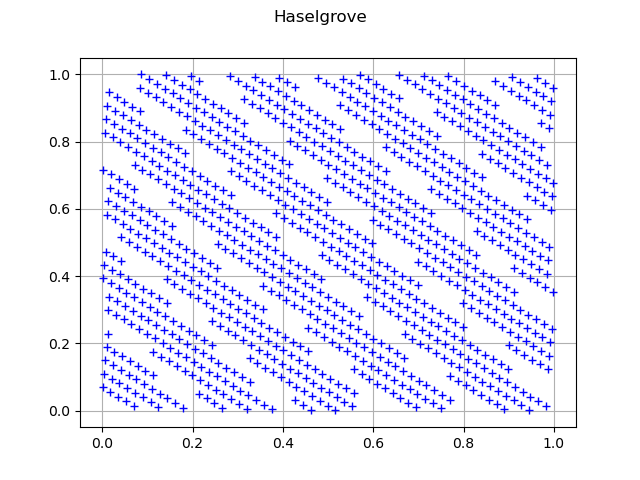Note
Click here to download the full example code
Generate low discrepancy sequences¶
In this examples we are going to expose the available low discrepancy sequences in order to approximate some integrals.
The following low-discrepancy sequences are available:
Sobol
Faure
Halton
reverse Halton
Haselgrove
To illustrate these sequences we generate their first 1024 points and compare with the sequence obtained from the pseudo random generator (Merse Twister) as the latter has a higher discrepancy.
from __future__ import print_function
import openturns as ot
import math as m
import openturns.viewer as viewer
from matplotlib import pylab as plt
ot.Log.Show(ot.Log.NONE)
Sobol sequence
dimension = 2
size = 1024
sequence = ot.SobolSequence(dimension)
sample = sequence.generate(size)
graph = ot.Graph("Sobol", "", "", True, "")
cloud = ot.Cloud(sample)
graph.add(cloud)
view = viewer.View(graph)

Halton sequence
dimension = 2
sequence = ot.HaltonSequence(dimension)
sample = sequence.generate(size)
graph = ot.Graph("Halton", "", "", True, "")
cloud = ot.Cloud(sample)
graph.add(cloud)
view = viewer.View(graph)

Halton sequence in high dimension: bad filling in upper dimensions
dimension = 20
sequence = ot.HaltonSequence(dimension)
sample = sequence.generate(size).getMarginal([dimension-2, dimension-1])
graph = ot.Graph("Halton (" + str(dimension - 2) + "," + str(dimension-1) + ")",
"dim " + str(dimension-2), "dim " + str(dimension-1), True, "")
cloud = ot.Cloud(sample)
graph.add(cloud)
view = viewer.View(graph)

Scrambled Halton sequence in high dimension
dimension = 20
sequence = ot.HaltonSequence(dimension)
sequence.setScrambling("RANDOM")
sample = sequence.generate(size).getMarginal([dimension-2, dimension-1])
graph = ot.Graph("Halton (" + str(dimension - 2) + "," + str(dimension-1) + ")",
"dim " + str(dimension-2), "dim " + str(dimension-1), True, "")
cloud = ot.Cloud(sample)
graph.add(cloud)
view = viewer.View(graph)

Reverse Halton sequence
dimension = 2
sequence = ot.ReverseHaltonSequence(dimension)
sample = sequence.generate(size)
print('discrepancy=',
ot.LowDiscrepancySequenceImplementation.ComputeStarDiscrepancy(sample))
graph = ot.Graph("Reverse Halton", "", "", True, "")
cloud = ot.Cloud(sample)
graph.add(cloud)
view = viewer.View(graph)

Out:
discrepancy= 0.0035074981424325635
Haselgrove sequence
dimension = 2
sequence = ot.HaselgroveSequence(dimension)
sample = sequence.generate(size)
graph = ot.Graph("Haselgrove", "", "", True, "")
cloud = ot.Cloud(sample)
graph.add(cloud)
view = viewer.View(graph)

Compare with uniform random sequence
distribution = ot.ComposedDistribution([ot.Uniform(0.0, 1.0)]*2)
sample = distribution.getSample(size)
print('discrepancy=',
ot.LowDiscrepancySequenceImplementation.ComputeStarDiscrepancy(sample))
graph = ot.Graph("Mersenne Twister", "", "", True, "")
cloud = ot.Cloud(sample)
graph.add(cloud)
view = viewer.View(graph)
plt.show()

Out:
discrepancy= 0.03623785775796684
Total running time of the script: ( 0 minutes 0.910 seconds)
 OpenTURNS
OpenTURNS